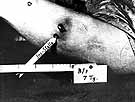
|
|
|

|

|

|

|
|
Click on an image to see a larger, more detailed picture.
|
|
|
|
|
| 1943: Death and Resistance |

|
pg. 422 |

|
|
|
|
| |
 The Bielski Partisans
The Bielski Partisans
Of the estimated 20,000 to 30,000 Jews who fought in partisan groups in the forests of Eastern Europe, the group led by Tuvia Bielski (pictured) was the largest and the most renowned. Though members of his family were murdered by Einsatzgruppen in Novogrudok, Tuvia escaped to the forests of western Belorussia. Together with his brothers Zusya, Asael, and Aharon, Tuvia secured arms and created a partisan group that grew to 30 members by summertime. This small band of Resistance fighters dispatched couriers to the ghettos in the Novogrudok region to recruit fellow Jews to join their camp. Eventually, Bielski's camp contained hundreds of families. The primary aim of the Bielski partisans was to protect Jewish lives. But they were also aggressive, launching raids against the Germans and exacting revenge on Belorussian police and farmers who helped the Nazis massacre Jews. Frustrated by the activities of the Bielski group, the Germans offered a large reward for Tuvia's capture. However, the group successfully escaped by retreating deep into the forest. When the area was liberated in the summer of 1944, Bielski's band of partisans numbered 1200. After the war, Tuvia immigrated to Palestine. He later settled in the United States with two surviving brothers.
Photo: Moshe Kaganovich / United States Holocaust Memorial Museum Photo Archive
|
 Within the walls of Auschwitz and other camps, humans replaced animals as subjects for experimentation. Unscrupulous surgeries were performed on inmates, both healthy and ill, and subjects were exposed to a variety of chemicals and viruses. Otherwise healthy prisoners were injected with typhus, tuberculosis, and malaria. This photo shows the results of a substance coded B/F, seven days after injection into a prisoner's forearm.
Within the walls of Auschwitz and other camps, humans replaced animals as subjects for experimentation. Unscrupulous surgeries were performed on inmates, both healthy and ill, and subjects were exposed to a variety of chemicals and viruses. Otherwise healthy prisoners were injected with typhus, tuberculosis, and malaria. This photo shows the results of a substance coded B/F, seven days after injection into a prisoner's forearm.
Photo: State Museum of Auschwitz-Birkenau / United States Holocaust Memorial Museum Photo Archive
|
 Jewish nurses and physicians struggled to care for the ill and injured within the ghettos. Pictured here are patients and family members in the Kovno (Lithuania) Ghetto. As trained medical personnel fell victim to disease and starvation, the ghetto's leadership sought to prepare new people to take their places. Secret medical training was offered in Warsaw and, most likely, Kovno.
Jewish nurses and physicians struggled to care for the ill and injured within the ghettos. Pictured here are patients and family members in the Kovno (Lithuania) Ghetto. As trained medical personnel fell victim to disease and starvation, the ghetto's leadership sought to prepare new people to take their places. Secret medical training was offered in Warsaw and, most likely, Kovno.
Photo: Beth Hatefutsoth
|
|

|

|

|

|
 February 1943: The slave-labor camp at Chrzanów, Poland, is dissolved, with 1000 laborers sent to the death camp at Auschwitz.
February 1943: The slave-labor camp at Chrzanów, Poland, is dissolved, with 1000 laborers sent to the death camp at Auschwitz.
|
 February 1943: The Nazis establish a Gypsy camp at Auschwitz-Birkenau.
February 1943: The Nazis establish a Gypsy camp at Auschwitz-Birkenau.
|
 February 1943: A young Jewish woman at Treblinka, stripped naked by her captors, grabs a rifle from a Ukrainian guard and kills two Germans and wounds a third before being subdued. She is subsequently tortured to death.
February 1943: A young Jewish woman at Treblinka, stripped naked by her captors, grabs a rifle from a Ukrainian guard and kills two Germans and wounds a third before being subdued. She is subsequently tortured to death.
|
 February 1943: German authorities direct Hungary to provide 10,000 Jews for copper-mine slave labor at Bor, Yugoslavia; See September 1943.
February 1943: German authorities direct Hungary to provide 10,000 Jews for copper-mine slave labor at Bor, Yugoslavia; See September 1943.
|
 February 1, 1943: Nazis kill 1500 Jews at Minsk, Belorussia, bringing the total number of Minsk victims since July 1941 to nearly 87,000.
February 1, 1943: Nazis kill 1500 Jews at Minsk, Belorussia, bringing the total number of Minsk victims since July 1941 to nearly 87,000.
|
|
|
|
|
| 1943: Death and Resistance |

|
pg. 422 |

|
|
The Holocaust Chronicle
© 2009 Publications International, Ltd.
|
|
